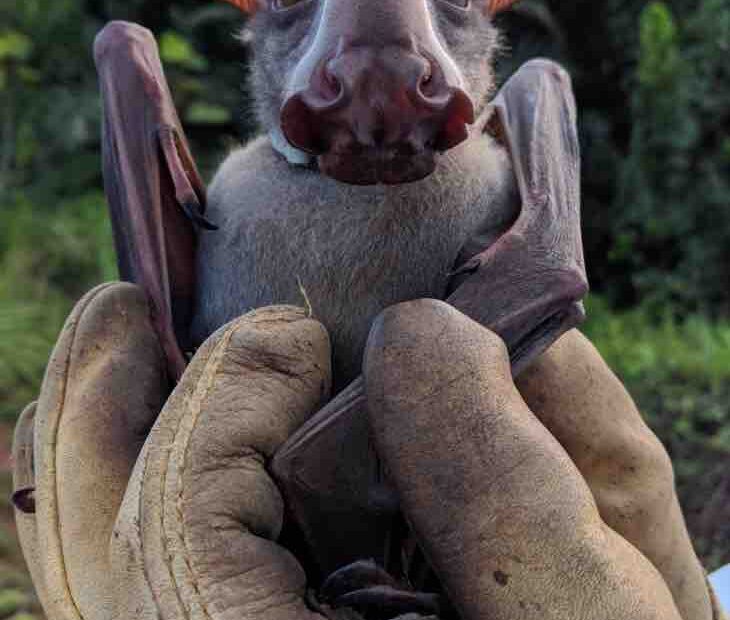In the tapestry of nature’s diverse creatures, hammerhead bats stand out for their unusual appearance, often leading to questions about their nature and behavior. A common query that arises is whether hammerhead bats are dangerous. Let’s find the truth behind these intriguing animals and debunk common myths surrounding them.
What are Hammerhead Bats?
Hammerhead bats, known for their distinctively shaped heads and large size, are the largest bats in Africa. They have garnered attention not just for their size but also for their unique facial structure, particularly prominent in males. These features have contributed to various myths and misconceptions, including the idea that hammerhead bats might be dangerous to humans.
What is Hammerhead Bats Habitat?
Firstly, understanding the habitat and behavior of hammerhead bats is crucial. These bats are found in the equatorial regions of Africa, inhabiting forested areas near water sources. They are frugivores, primarily feeding on fruits, and play a vital role in their ecosystem as seed dispersers. Their nocturnal nature and diet clearly indicate that their interaction with humans is minimal.
Are Hammerhead Bats Aggressive?
The behavior of hammerhead bats does not suggest any inherent aggression towards humans. They are generally shy and elusive, preferring to stay away from human activity. Their diet consists of fruit, making them unlikely to come into contact with humans in a way that could be perceived as threatening.
What are Hammerhead Bats Misconceptions?
One reason for the fear surrounding hammerhead bats and other bat species is the concern about disease transmission. While it’s true that bats can be carriers of various diseases, the risk of transmission to humans is relatively low. Hammerhead bats are not known to carry diseases that are commonly associated with bats, such as rabies or Ebola. It is always wise, however, to avoid direct contact with wild animals, including hammerhead bats, as a general precaution.
The Role of Hammerhead Bats in Pollination and Seed Dispersal
Far from being dangerous, hammerhead bats are actually beneficial to their environment. Their feeding habits contribute significantly to seed dispersal and pollination, processes vital for the health of their ecosystems. By consuming fruits and carrying seeds to new locations, hammerhead bats aid in the regeneration and spread of various plant species.
What are some Myths around Hammerhead Bats?
In some African cultures, hammerhead bats have been subjects of folklore and myth, sometimes portrayed in a negative light due to their unusual appearance.
The myth surrounding hammerhead bats largely stems from their unique and somewhat intimidating appearance. These bats, which are native to equatorial Africa, have a distinctive hammer-like shape to their heads, especially pronounced in males. This unusual feature, combined with their large size (they are among the largest bats in Africa), can make them appear daunting or menacing.
One common myth is that hammerhead bats are dangerous to humans. This misconception might arise from their ominous appearance and the general fear and misunderstanding that often surrounds bats. In reality, hammerhead bats are frugivores, meaning their diet consists primarily of fruit. They play an important ecological role as seed dispersers and pollinators in their habitats. They are not aggressive towards humans and, like most bats, prefer to avoid human contact.
Another aspect of the myth is related to disease transmission. Bats, in general, are often wrongly perceived as major carriers of deadly diseases to humans. While it’s true that bats can be natural reservoirs of various viruses, the risk of transmission to humans is relatively low, especially in the case of fruit-eating species like the hammerhead bat. Direct contact with wild bats should be avoided, but the fear of disease transmission often exceeds the actual risk.
In some local cultures, the hammerhead bat may be associated with superstitions or folklore due to its distinctive appearance. Such cultural interpretations can sometimes contribute to fear or misunderstanding about the species.
Overall, the myths around hammerhead bats are a mix of fear due to their appearance, misconceptions about their behavior, and overestimation of the risks they pose to humans. Education and awareness are key in dispelling these myths and highlighting the important role these bats play in their ecosystems.
What is Hammerhead Bats Conservation Status?
While hammerhead bats are currently listed as a species of least concern by the IUCN, they face threats from habitat loss and hunting. Conservation efforts are important for protecting these unique bats, which, in turn, helps maintain the health and diversity of the ecosystems they inhabit.
Conclusion: Understanding, Not Fear
Hammerhead bats are not dangerous to humans. Misconceptions about their behavior and the diseases they carry can lead to unwarranted fear. In reality, these bats are an important part of their ecosystems, contributing to processes like seed dispersal and pollination. Understanding the role of hammerhead bats in nature and their behavior patterns is crucial. They deserve our respect and protection, not fear and aversion.
Image courtesy: https://en.wikipedia.org/wiki/Hammer-headed_bat
